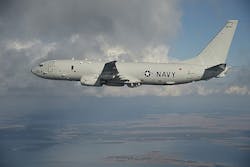Boeing to upgrade sonar signal processing on Navy P-8A anti-submarine warfare (ASW) aircraft
Officials of the Naval Air Systems Command at Patuxent River Naval Air Station, Md., are asking the Boeing Defense, Space & Security segment in Huntington Beach, Calif., to make enhancements to the P-8A's acoustics subsystem, which is the backbone of the plane's ASW capabilities. The Poseidon is a militarized version of the Boeing 737 single-aisle jetliner.
The Navy is asking Boeing for P-8A increment 3 block 2 acoustics subsystem capability enhancements, software updates, acoustics system and subsystem software sustainment, technical support, management, defect correction, modernization, enhancements, improvements, and obsolescence mitigation.
Increment 3 block 2 capabilities and architecture upgrades to the P-8A aircraft installs hardware and software upgrades for a service-oriented applications based architecture (ABA), track management system, acoustics improvements, and ASW signals intelligence (SIGINT) systems using existing P-8A controls and displays.
The goal of the P-8A increment 3 block 2 technology initiative is to carry out a combat system upgrade to the plane based on an open-systems approach that interfaces and works with existing systems while supporting future capability integration.
Related: Navy boosting C4ISR, multi-sensor intelligence capabilities of P-8A Poseidon ASW aircraft
The Boeing-built acoustics subsystem for the P-8A builds on previous upgrades, which included the Multistatic Active Coherent Capability (MAC) that uses the SSQ-125 sonobuoy. The SSQ-125 generates loud sounds electronically rather than using small explosive charges to generate sound.
The SSQ-125 sonobuoy intercepts long-range echoes from submarine contacts and relays them to the P-8A aircraft’s sensor system. Navy officials say that electronic sound sources generate fewer false returns than do explosive charges.
Previous upgrades to the P-8A also included the Automatic Information System and the High-Altitude ASW Weapon (HAAWC) system. HAAWC is a flying MK 54 torpedo designed to be released from high altitudes and enter the water close by enemy submarines with little warning.
The HAAWC system has a Boeing-built wing kit, a Global Positioning System (GPS), and a data link with the aircraft. The weapon can glide from high altitudes to enable the P-8A aircraft to maintain a wide search area and increased standoff ranges from threats.
The sonobuoys that P-8As deploy also have GPS satellite navigation capability to enable the aircraft to maintain a precise plot of the sonobuoy field at altitudes of 10,000 feet or higher.
Overall, P-8A increment 3 capabilities address broad area anti-submarine warfare (ASW), anti-surface warfare (ASuW), intelligence, surveillance and reconnaissance (ISR), and network-ready requirements, as part of the P-8A's modern open-architecture and affordable mission systems. The goal is to develop and deploy new capabilities quickly instead of waiting to deliver as one package.
P-8A increment 3 system upgrades will stay within the available size, weight, and power, and cooling (SWAP-C) margins of the fielded P-8A aircraft. Boeing is delivering P-8A increment 3 block 3 capabilities as hardware and software retrofits to the aircraft.
The P-8A increment 3 block 2 program is integrating a combat system with open architecture equipment that includes a new computing and security applications based architecture (ABA), a higher-than-secret (HTS) architecture, an improved track management subsystem (TMS), acoustics, multi-static active coherent enhancements (MAC-E), and ASW SIGINT changes.
For more information contact Boeing Defense, Space & Security online at www.boeing.com/defense, or Naval Air Systems Command at www.navair.navy.mil.
Learn more: search the Aerospace & Defense Buyer's Guide for companies, new products, press releases, and videos
